吉林大学:《药理学》课程PPT教学课件(七年制)Treatment of Congestive Heart Failure
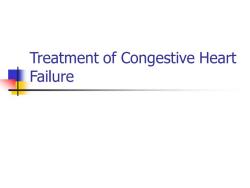
Treatment of Congestive Heart Failure
Treatment of Congestive Heart Failure
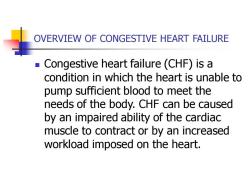
OVERVIEW OF CONGESTIVE HEART FAILURE Congestive heart failure (CHF)is a condition in which the heart is unable to pump sufficient blood to meet the needs of the body.CHF can be caused by an impaired ability of the cardiac muscle to contract or by an increased workload imposed on the heart
OVERVIEW OF CONGESTIVE HEART FAILURE ◼ Congestive heart failure (CHF) is a condition in which the heart is unable to pump sufficient blood to meet the needs of the body. CHF can be caused by an impaired ability of the cardiac muscle to contract or by an increased workload imposed on the heart
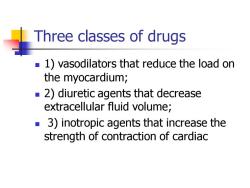
Three classes of drugs 1)vasodilators that reduce the load on the myocardium; 2)diuretic agents that decrease extracellular fluid volume; 3)inotropic agents that increase the strength of contraction of cardiac
Three classes of drugs ◼ 1) vasodilators that reduce the load on the myocardium; ◼ 2) diuretic agents that decrease extracellular fluid volume; ◼ 3) inotropic agents that increase the strength of contraction of cardiac
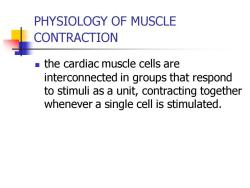
PHYSIOLOGY OF MUSCLE CONTRACTION the cardiac muscle cells are interconnected in groups that respond to stimuli as a unit,contracting together whenever a single cell is stimulated
PHYSIOLOGY OF MUSCLE CONTRACTION ◼ the cardiac muscle cells are interconnected in groups that respond to stimuli as a unit, contracting together whenever a single cell is stimulated
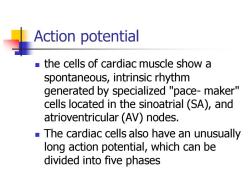
Action potential the cells of cardiac muscle show a spontaneous,intrinsic rhythm generated by specialized "pace-maker" cells located in the sinoatrial (SA),and atrioventricular (AV)nodes. The cardiac cells also have an unusually long action potential,which can be divided into five phases
Action potential ◼ the cells of cardiac muscle show a spontaneous, intrinsic rhythm generated by specialized "pace- maker" cells located in the sinoatrial (SA), and atrioventricular (AV) nodes. ◼ The cardiac cells also have an unusually long action potential, which can be divided into five phases
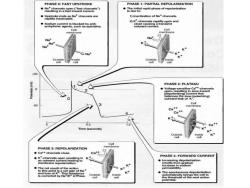
PHASE 0:FAST UPSTROKE PHASE 1:PARTIAL REPOLARIZATION ·to8am) rapid phase of repolarization ·ae产channels are 1)inactivation of Nachannels. ·mec2 uiniine Cell Na+ Na +50 PHASE 2:PLATEAU Ca++ Ca+ Ca+ Time (seconds) PHASE 3:REPOLARIZATION ●Cat+-channels close. Ca PHASE 4:FORWARD CURRENT ·99C8o sodium K K potential
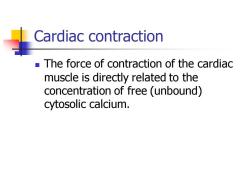
Cardiac contraction The force of contraction of the cardiac muscle is directly related to the concentration of free (unbound) cytosolic calcium
Cardiac contraction ◼ The force of contraction of the cardiac muscle is directly related to the concentration of free (unbound) cytosolic calcium
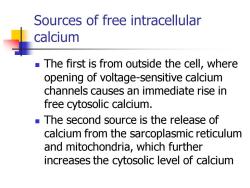
Sources of free intracellulan calcium The first is from outside the cell,where opening of voltage-sensitive calcium channels causes an immediate rise in free cytosolic calcium. -The second source is the release of calcium from the sarcoplasmic reticulum and mitochondria,which further increases the cytosolic level of calcium
Sources of free intracellular calcium ◼ The first is from outside the cell, where opening of voltage-sensitive calcium channels causes an immediate rise in free cytosolic calcium. ◼ The second source is the release of calcium from the sarcoplasmic reticulum and mitochondria, which further increases the cytosolic level of calcium
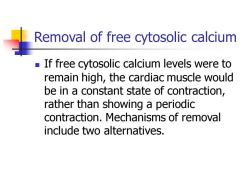
Removal of free cytosolic calcium If free cytosolic calcium levels were to remain high,the cardiac muscle would be in a constant state of contraction, rather than showing a periodic contraction.Mechanisms of removal include two alternatives
Removal of free cytosolic calcium ◼ If free cytosolic calcium levels were to remain high, the cardiac muscle would be in a constant state of contraction, rather than showing a periodic contraction. Mechanisms of removal include two alternatives
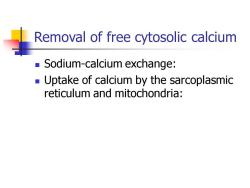
Removal of free cytosolic calcium Sodium-calcium exchange: Uptake of calcium by the sarcoplasmic reticulum and mitochondria:
Removal of free cytosolic calcium ◼ Sodium-calcium exchange: ◼ Uptake of calcium by the sarcoplasmic reticulum and mitochondria:
按次数下载不扣除下载券;
注册用户24小时内重复下载只扣除一次;
顺序:VIP每日次数-->可用次数-->下载券;
- 吉林大学:《药理学》课程PPT教学课件(七年制)Macrolides(Erythromycin).ppt
- 吉林大学:《药理学》课程PPT教学课件(七年制)Drugs Used to Treat Epilepsy.ppt
- 吉林大学:《药理学》课程PPT教学课件(七年制)Antianginal Drugs.ppt
- 吉林大学:《药理学》课程PPT教学课件(七年制)Anticancer Drug.ppt
- 吉林大学:《药理学》课程PPT教学课件(七年制)Anti hypertensive Drugs.ppt
- 吉林大学:《药理学》课程PPT教学课件(七年制)Anxiolytic and hypnotic drugs.ppt
- 吉林大学:《药理学》课程PPT教学课件(七年制)Neuroleptic drugs.ppt
- 吉林大学:《药理学》课程PPT教学课件(七年制)Treatment of Parkinson’s disease.ppt
- 吉林大学:《药理学》课程PPT教学课件(七年制)Antidepressant drugs.ppt
- 吉林大学:《药理学》课程PPT教学课件(七年制)Antimicrobial Agents - General Consideration.ppt
- 吉林大学:《药理学》课程PPT教学课件(七年制)β-Lactam Antibiotics.ppt
- 吉林大学:《药理学》课程PPT教学课件(七年制)Chemotherapeutic Medicine.ppt
- 吉林大学:《药理学》课程PPT教学课件(七年制)Antituberculous drug.ppt
- 吉林大学:《药理学》课程PPT教学课件(七年制)The autonomic nervous system.ppt
- 吉林大学:《药理学》课程PPT教学课件(七年制)Introduction to Pharmacology.ppt
- 吉林大学:《药理学》课程PPT教学课件(七年制)Beta-adrenergic blocking agents.ppt
- 吉林大学:《药理学》课程PPT教学课件(七年制)Adrenergic agonists.ppt
- 吉林大学:《药理学》课程PPT教学课件(五年制)第四十五章 抗结核病药及抗麻风病药.ppt
- 吉林大学:《药理学》课程PPT教学课件(五年制)第十五章 镇静催眠药 Sedatives and hypnotics.ppt
- 吉林大学:《药理学》课程PPT教学课件(五年制)第十八章 抗精神病药.ppt
- 吉林大学:《药理学》课程PPT教学课件(七年制)Drugs Affecting Blood.ppt
- 吉林大学:《药理学》课程PPT教学课件(七年制)Drugs Affecting the Respiratory System.ppt
- 吉林大学:《药理学》课程PPT教学课件(七年制)Opioid Analgesics and Antagonists.ppt
- 吉林大学:《药理学》课程PPT教学课件(七年制)Diuretic Drugs.ppt
- 吉林大学:《药理学》课程PPT教学课件(七年制)Antiarrhythmic drugs.ppt
- 《药理学》课程教学资源(讲义)药理学步进教程(共四十九章).docx
- 石河子大学:《药理学》课程教学资源(教案,共二十八讲).docx
- 《药理学》课程教学资源(讲义)第一篇 药理学总论.pdf
- 《药理学》课程教学资源(讲义)第二篇 传出神经系统药理.pdf
- 《药理学》课程教学资源(讲义)第三篇 中枢神经系统药理.pdf
- 《药理学》课程教学资源(讲义)第四篇 心血管药理.pdf
- 《药理学》课程教学资源(讲义)第五篇 内脏药理.pdf
- 《药理学》课程教学资源(讲义)第六篇 内分泌药理.pdf
- 《药理学》课程教学资源(讲义)第七篇 化疗药物.pdf
- 《药理学》课程教学资源(实验指导)实验二 常用实验动物的捉拿固定和给药方法.pdf
- 《药理学》课程教学资源(实验指导)实验三 不同剂量、不同给药途径、不同机能状态对药物作用的影响.pdf
- 《药理学》课程教学资源(实验指导)实验四传出神经系统药理实验.pdf
- 《药理学》课程教学资源(实验指导)实验五传出神经系统药物对离体肠管的作用.pdf
- 《药理学》课程教学资源(实验指导)实验六局部麻醉药实验.pdf
- 《药理学》课程教学资源(实验指导)实验七 中枢神经系统药理实验.pdf
